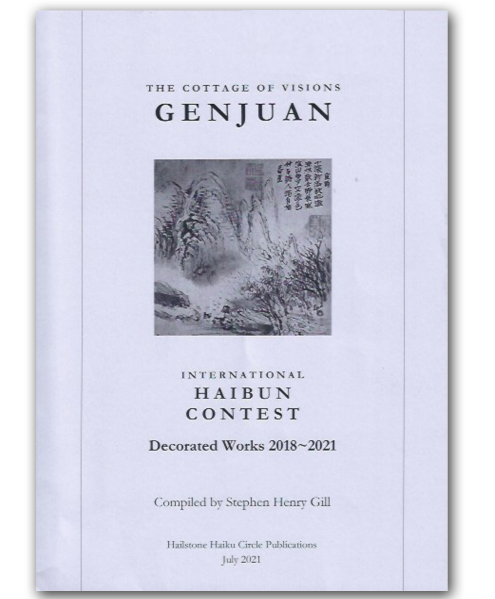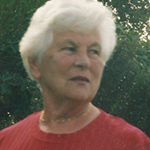
Book Review: The Cottage of Visions
Genjuan International Haibun Contest Decorated Works 2018-2021
Compiled by Stephen Henry Gill
Published by Hailstone Haiku Circle Publications
2021, paperback, 160 page
ISBN: 978-4-9911809-1-0
$18 U.S. including p&p
Ordering Information
Reviewed by Patricia Prime
Genjuan is the name of the cottage near Lake Biwa where Basho lived for some time, and where he wrote one of his most famous haibun (“The Unreal Dwelling”). Genjuan is also the name of an annual contest that, since 2012, has celebrated English-language haibun and (according to its guidelines) tried “to maintain the connection between the traditional Japanese perception of haiku-style prose and what is evolving around the world.”
Founded by Nobuyuki Yuasa and Stephen Henry Gill (who initially served as judges), the Genjuan International Haibun Contest was actually a continuation of a competition the pair had begun in 2009, sponsored by the Kikakuza organization in Kanagawa, Japan. Every few years, the winning entries were compiled into anthologies. The Cottage of Visions: Genjuan International Haibun Contest Decorated Works 2018-2021 is the latest such collection—the fourth, as Gill notes in his preface, if the Kikakuza 2009-11 anthology is included. The Cottage of Visions is also, Gill notes, the last collection, as 2021 marked the end of the competition.
The book is a fitting capstone. Topics vary; there are many memories of family and friends, several travelogues and regional descriptions, even a few reflections on war and homelessness. Poets from across the globe are represented, and there’s plenty to recommend from among their submissions. They succeed in merging the core elements of the form—a strong title, lucid prose, and spare haiku—into cohesive, well-structured wholes.
In each of the yearly contests, the judges selected 10 works for recognition—one Grand Prix award, several An (Cottage) prizes for highly commended works , and a number of Honorable Mention pieces. (A full listing of all the winning entries, with examples, is given at the end of this review.) In making their selections, they paid special attention to those haibun that honored “the spirit of haikai,” the features of which were noted in the contest guidelines as “the subtle linking of haiku with prose, omission prompting the reader’s imagination, humour, and self-deprecation.” Here are excerpts from the four Grand Prix winners, which show not only what the judges viewed as best portraying that spirit, but also the range of voices in the book:
2018:
unweeded garden:
out of long grass
a praying mantisIn any event, it looked quite at home procrastinating on a wooden plank in warm November sunshine. After a while I decided to test the critter’s resolve, so I placed my hand right in front of its face. It did not budge at all. I stomped hard on the plank. Still nothing. I then nudged the creature a few inches away and for a moment it lost balance but was soon back on its feet, boldly pacing back to the original resting spot. My repeated experiments yielded the same result.
on sunlit stage
insect
refusing to bow(from “The Forbidden Pet” by Branko Manojilović, Japan)
2019:
I spent my youthful summers in a mining town on the coal fields of Northumberland, the land of the geordies. I played soccer in the alley with lads destined to go down the pit. Miners hewed coal in the deeps below the North Sea, hauled in cages by a large wheel at the colliery head. They wore aprons on their backs to protect them from the low rock ceiling and to keep their trouser seats dry as they picked at the coal, seated on a cracket for leverage. Huge piles of pit slag spontaneously combusted like small volcanoes.
lamps glow yellow
at the coal-face
the canary still sings(from “Memories of a Coal-Miner’s Grandson” by Bryan D. Cook, Canada)
2020:
To begin with nothing sullies the snow,
not a footprint on paths, no print of hand
on bonnets of cars. No animal shows itself,
no puss cat tests it with a dangling paw,
no rabbit sniffs it. Just a small fluffed-up bird,
such as blackbird, tit, goldfinch, thrush
has left here and there some hungry impression.
There’s a shout for cameras,
reminder to put on woolly caps, boots, scarves. . .snowballs
even the rose bushes
starting to throw them(from “Snow in Advent” by David Cobb, U.K.)
2021:
Wild-eyed with open maw comes this mass of tangled fur loping full tilt through the frothy surf. My fists spring from their pockets, ready to fight a creature from whom there will be no retreat. In seconds the growling beast is upon me, and only then do I spot the yellow tennis ball, gritty with sand, clenched between its gleaming teeth.
This amiable Old English Sheepdog sans color and leash halts at my feet, drops his quarry, backs off, looks up, all slobber and smile, reminding me of my first best friend, another playful mutt and tireless stick-fetcher I lost so long ago.
Sirius rising
the bark of a sea lion
buried between the waves(from “A Mead-Hall of the Mind” by J Hahn Doleman, U.S.A.)
As in the past Genjuan anthologies, the entries of each year’s contest are grouped together and followed by comments from the judges. For these rounds, only Gill remained a constant throughout. In 2014, he and Yuasa had been joined by Hisashi Miyazaki, who remained through the 2019 contest. In 2015, following Yuasa’s retirement, Nenten Tsubo’uchi joined the judges and remained through 2018. Other judges included Ellis Avery (2017), Angelee Deodhar (2018), Toru Kiuchi (2019), Akiko Takazawa (2020-21), and Sean O’Connor (2020-21). Their comments offer a “behind the scenes” look at how each judge came to his or her selections and what propelled certain pieces ahead of others. They also note (sometimes bluntly) why some haibun did not rank higher: a “laboured” or “lame” title (Gill in particular pulls no punches), prose that’s a bit obscure or too personal, a haiku that “falls flat” or relies too much on the prose. The comments also show how the contest is trying to maintain that balance between tradition and evolution—as Gill notes, “to bridge the distance between Japan and the rest of the world in haibun perception.” Here are two from Gill:
Somewhere in the Kyorai-sho (Records of Basho’s teaching made by his disciple Mukai Kyorai), we find the Master saying, “Although we might (on occasion) borrow Chinese words, we should write in a style which impresses the reader with its smoothness. Likewise, although, sometimes we may refer to things using vulgar terms, we must write in a way that creates sympathy in the reader.” Well, there, in a nutshell, you have it: we can use Japanese words, Irish words, Aboriginal words, but they should not get stuck in our throats; we can portray sickness and depravity, but only if we do it so that the reader does not turn away. Impenetrably obscure or intellectual pieces, as well as unremitting or crazed accounts came along, as they always do, in this year’s entry bundle, but smoothness and accessible resonance should be our aims.
[T]he difference between haiku and senryu … is something worth keeping in mind. Editors of Western haiku journals and websites used to try to distinguish between the two genres. Not so much today. Haiku traditionally make references to nature, whereas senryu are generally about the human condition. Thus, if a haibun has no reference to nature, to season, to the moon or sun, no window out of the psychological drama—funny or sad—it describes, it is unlikely to be a fine example of haibun.
Whether or not you agree with the judges’ views and critiques, they provide valuable insights into the evaluation process, along with food for thought.
The Cottage of Visions ends with three “haikai-style” works from the 17th century (by Basho, Kyorai, and Kikaku), a sampling of the judges’ own haibun, and a postscript by Nobuyuki Yuasa that sums up the Genjuan contest’s goals and outcomes:
I sacrificed both time and money to keep the Contest going, but I have nothing but gratifying memories as I look back. Although my dream of reviving the long-dead tradition of haibun in Japan has not yet been achieved, that other dream of mine—to foster English haibun by creating a Japan-based international contest— has been warmly received by haibun lovers of the world. My gratitude goes to them for supporting it..
With this last collection, the gratitude flows straight back.
Genjuan Winners by Year, 2018-2021
Decorated Works 2018: There were 133 entries from 15 countries. The Grand Priz award went to Branko Manojlovic for the “Forbidden Pet.” Cottage Prizes were won by Marietta McGregor, Ignatius Fay, and Chris Bays. Honourable Mentions were awarded to Sean O’Connor, Marina Bellini, Dru Philippou, Beth A. Skala, Pearl Elizabeth Dell May, and David McCullough.
Decorated Works 2019: There were 95 entries from 19 countries. The Grand Prix went to Bryan D. Cook for “Memories of a Coal-Miner’s Grandson.” The An (Cottage) Prizes were awarded to Judy Kendal, Marcyn Del Clements, Sean O’Connor, and Branko Manojlovic. Honourable Mentions were won by Jeff Doleman, Diana Webb, Ignatius Fay, Joan Prefontaine, and Terry Ann Carter.
Decorated Works 2020: There were 97 entries from 18 countries. The Grand Prix was awarded to David Cobb’s haibun “Snow in Advent.” The An (Cottage) Prizes were awarded to David McCullough and Joan Prefontaine. Honourable Mentions went to Kanchan Chatterjee, Paul Bregazzi, Naomi Beth Wakan, Geethanjali Rajan, Sydney Solis, Cesar-Florin Ciobica, and Dick Pettit.
Decorated Works 2021: There were 139 entries from approximately 20 countries. The Grand Prix went to J Hahn Doleman for “A Mead-Hall of the Mind.” The An (Cottage) Prizes were awarded to Marietta McGregor, Manoj Nair, and Matthew Caretti. Honorable Mentions were awarded to Glenda Cimino, Akihiko Hayashi, Margherita Petriccione, Jennifer Hambrick, Margaret Chula, and Diarmuid Fitzgerald.
About the Reviewer

Patricia Prime is co-editor of the NZ haiku journal Kokako. She was the reviews/interviews editor of Haibun Today and presently is a reviewer for Atlas Poetica, Takahe, and other journals. Besides reviewing, she writes traditional verse, renga, linked verse, tanka prose, haibun, cherita, and limericks, as well as collaborative verse and renga with a variety of poets.
